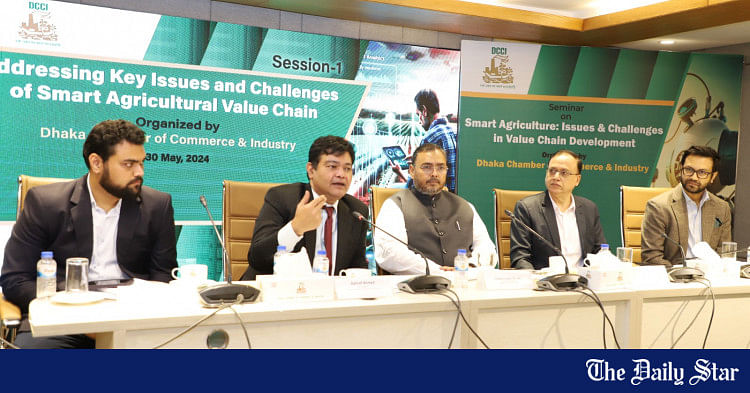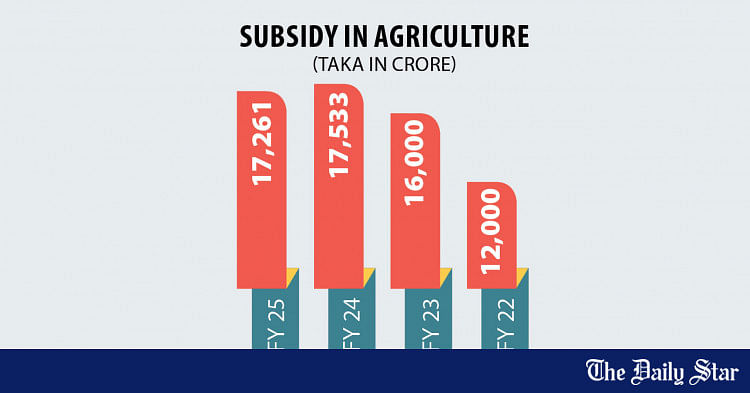বারো ভূঁইয়ার শাসনামলে সোনারগাঁ বাণিজ্যের জন্য খুবই বিখ্যাত ছিল। পর্তুগিজরা প্রথম এ অঞ্চলে লিচুর চারা নিয়ে আসেন, তখন থেকেই এখানে লিচু চাষ হয়।

bangla.thedailystar.net
কম ফলনে হতাশ সোনারগাঁয়ের আগাম জাতের লিচু চাষিরা
বারো ভূঁইয়ার শাসনামলে সোনারগাঁ বাণিজ্যের জন্য খুবই বিখ্যাত ছিল। পর্তুগিজরা প্রথম এ অঞ্চলে লিচুর চারা নিয়ে আসেন, তখন থেকেই এখানে লিচু চাষ হয়।
View attachment 5912
স্টার ফাইল ছবি
আগাম জাতের হওয়ায় নারায়ণগঞ্জের সোনারগাঁ উপজেলার লিচু বাগানগুলোতে তুলনামূলক দ্রুত ফল আসে। তবে এ বছর টানা তাপদাহ ও শিলাবৃষ্টিতে লিচুর উৎপাদন কম হয়েছে। বাগান মালিকদের আশঙ্কা, এবার আশানুরূপ মুনাফার দেখা পাওয়া যাবে না।
বাগান মালিক ও কৃষি কর্মকর্তাদের সঙ্গে কথা বলে জানা যায়, নারায়ণগঞ্জের মাটি ও আবহাওয়া লিচু চাষের উপযোগী। যদিও, কেবল সোনারগাঁ উপজেলাতেই লিচুর চাষ হয়। এ বছর উপজেলার ১২টি গ্রামের অন্তত ১০৭ হেক্টর জমিতে ৭৮০টি বাগানে লিচুর বাণিজ্যিক চাষ করা হয়েছে। সাধারণত কদমি, পাতি ও চায়না-৩; এই তিন জাতের লিচু গাছ আছে এসব বাগানে।
সোনারগাঁ উপজেলা কৃষি কর্মকর্তা আফরোজা ইসলাম দ্য ডেইলি স্টারকে বলেন, গতবছর বাগানগুলোতে ৭০০ মেট্রিক টন লিচু উৎপাদন হয়েছিল। এ বছর বাগানের সংখ্যা বাড়ায় উৎপাদন বেশি হবে বলে আশা ছিল। কিন্তু অত্যধিক গরম ও শিলাবৃষ্টির কারণে এ বছরও ৭০০ মেট্রিক টন উৎপাদন হতে পারে।
গত মঙ্গলবার সোনারগাঁওয়ের ঐতিহ্যবাহী পানাম নগর, চিলারবাগ, উত্তর ষোলপাড়া গ্রামে ঘুরে রাস্তার দুইপাশে সারি সারি লিচু বাগান দেখা যায়। অধিকাংশ বাগানের মালিক মৌসুমি ব্যবসায়ীদের কাছে আগাম বাগান ইজারা দেন। গাছে ফুল আসা থেকে ফলের পরিচর্যা ও লিচু বাজারজাত করা পর্যন্ত সবকিছুই করেন ব্যবসায়ীরা।
মৌসুমি লিচু ব্যবসায়ী রনি আহমেদ এবার ৩০ শতাংশ আয়তনের একটি বাগার ৮৫ হাজার টাকায় ইজারা নিয়েছেন। গাছের পরিচর্যা ও অন্যান্য কাজে বিনিয়োগ করেছেন আরও ২৫ হাজার টাকা। তবে, ভালো ফলন না হওয়ায় হতাশ রনি।
'আমি অন্তত ৩০ হাজার লিচু পাওয়ার আশা করছিলাম। গত দুই দিনে লিচু পেয়েছি মাত্র ২০ হাজার। অথচ দুই বছর আগেও এই বাগান থেকে ৩৬ হাজার লিচু পেয়েছি। এ বছর সময়মতো বৃষ্টি হয় নাই, সেই সঙ্গে ভীষণ গরম ছিল। এজন্য লিচু ঠিকমতো বড় হয়নি। শেষে শিলাবৃষ্টিতে অনেক লিচু নষ্ট হয়ে গেছে', বলেন তিনি।
গাছ থেকে লিচু পেড়ে কুমিল্লার দাউদকান্দিতে একটি আড়তে বিক্রি করার সিদ্ধান্ত নিয়েছেন রনি। তিনি বলেন, 'বাগানভাড়া ও অন্যান্য খরচ বাদ দিলে হাতে কিছু টাকা থাকবে। কিন্তু পুরো মৌসুমে যে পরিশ্রম করছি এর তুলনায় এটা কিছু না।'
প্রায় একই অভিজ্ঞতার কথা জানান এ অঞ্চলের বড় বাগানের মালিকরা।
উত্তর ষোলপাড়া গ্রামে ২৭০ শতাংশেরও বেশি জমিতে একটি লিচু বাগান করা হয়েছে। এ বাগানে লিচু গাছ আছে ৮৬টি। মঙ্গলবার দুপুরে বাগানটিতে কয়েকজনকে লিচু পেড়ে বাজারে নিয়ে যাওয়ার প্রস্তুতি নিতে দেখা যায়।
এই বাগানের দেখাশোনা করেছেন ৫৯ বছর বয়সী বেনু মোল্লা। দীর্ঘ ৩৫ বছর বিভিন্ন লিচু বাগানে কাজ করা এই প্রবীণ দ্য ডেইলি স্টারকে বলেন, মাঘ মাসের শেষ দিকে সোনারগাঁয়ের লিচু গাছে ফুল দেখা যায়। লিচু পাড়া শুরু হয় বৈশাখের মাঝামাঝি সময়ে। লিচুর ফলন ভালো হওয়ার জন্য পর্যাপ্ত বৃষ্টি ও অনুকূল আবহাওয়া জরুরি।
বাগানটি ভাড়ায় নেওয়া মো. হানিফ বলেন, 'এবার গাছে ভালো ফুল আসছিল। এইটা দেইখা অন্যবার একটি বাগান লিজ নিলেও এবার তিনটা নিছি। কিন্তু এখন পড়ছি মুশকিলে। রইদের তাপে কোনো সমস্যা ছিল না, যদি সময়মতো বৃষ্টি হইতো। যেই আশায় তিনটা বাগান লিজ নিছিলাম সেই আশা পূরণ হইবো না। কারণ ফলন কম।'
আশানুরূপ ফলন না হলেও লিচু বাজারজাত করতে কোনো ঝামেলা পোহাতে হয় না বলে জানান বাগান মালিক ও মৌসুমি ব্যবসায়ীরা। বেশিরভাগ লিচু উপজেলার মোগরাপাড়া বাজারে ফলের আড়তে বিক্রি হয়। সেখান থেকে রাজধানী ও আশেপাশের এলাকার ফলের বাজারে পৌঁছে যায় লিচু। প্রতি হাজার লিচু তিন-পাঁচ হাজার টাকায় বিক্রি হচ্ছে এ বছর। তবে চায়না-৩ জাতের লিচুর দাম তুলনামূলক বেশি।
এছাড়া, সোনারগাঁ লোক ও কারুশিল্প জাদুঘর এবং পানাম নগরে বেড়াতে আসা দর্শনার্থীরাও লিচু কিনে নিয়ে যান বলে জানান বাগান মালিকরা।
কৃষি কর্মকর্তা আফরোজা দ্য ডেইলি স্টারকে বলেন, বারো ভূঁইয়ার শাসনামলে সোনারগাঁ বাণিজ্যের জন্য খুবই বিখ্যাত ছিল। পর্তুগিজরা প্রথম এ অঞ্চলে লিচুর চারা নিয়ে আসেন, তখন থেকেই এখানে লিচু চাষ হয়। তবে বাণিজ্যিক চাষ গত কয়েকবছর ধরে বেড়েছে।
'সোনারগাঁয়ের লিচু দেশের অন্যান্য অঞ্চলের তুলনায় অন্তত একমাস আগে বাজারে আসে। দিনাজপুরের লিচু বাজারে আসে আরও কিছুদিন পর। এসব কারণে সোনারগাঁয়ের লিচুর কদর বেশি। বর্তমানে রাজধানীর কাওরানবাজারসহ বিভিন্ন এলাকার বাজারে যেসব লিচু পাওয়া যাচ্ছে এর ৯০ শতাংশই সোনারগাঁয়ে উৎপাদিত।'
এদিকে, এ বছর ফলন কম হওয়ার পেছনে আরও একটি কারণের কথা জানালেন এ কৃষি কর্মকর্তা।
তিনি বলেন, 'এই উপজেলায় অনেক বাগানমালিক আছেন যারা বাগান ভাড়া দিয়ে দেন। ভাড়াটে চাষিরা অনেক সময় গাছের সঠিক পরিচর্যা করেন না। এমনকি কৃষি কর্মকর্তাদেরও পরামর্শ নিতে আসেন না। তীব্র তাপদাহে নিয়মিত পানি ব্যবহার ও সেচের প্রয়োজন আছে। তাছাড়া, লিচু পাড়ার পরও বাগানের পরিচর্যা করতে হয়, নইলে পরের বছর ভালো ফলন পাওয়া যায় না। এক্ষেত্রে অনেকেই উদাসীন।'
তবে, নিজেদের সীমাবদ্ধতার কথা জানিয়ে আফরোজা বলেন, 'বাগান মালিক ও চাষিদের আমরা সবসময় পরামর্শ দিয়ে সহযোগিতা করি। গাছে কীটনাশক ছিটানোর মেশিনও দেওয়া হয়। কিন্তু আমাদের কাছে পর্যাপ্ত মেশিন নেই। এজন্য উপজেলা নির্বাহী কর্মকর্তার কাছে চাহিদাপত্র দেওয়া আছে।'
I will add English transliteration so non-Bengali speakers can understand the content.
---------------------------------------------------------------------------------------------------------------------------------------------------------------------
Early variety litchi farmers in Sonargaon are disappointed with low yield
During the reign of Baro Bhuiyan, Sonargaon was very famous for trade. The Portuguese first brought litchi seedlings to the region, and since then litchi has been cultivated here.
As it is an early variety, litchi gardens of Sonargaon upazila of Narayanganj bears fruit relatively quickly. But this year litchi production has decreased due to continuous heat and hail. Garden owners are afraid, this time they will not see the expected profit.
Talking to garden owners and agricultural officials, it is known that Narayanganj's soil and climate are suitable for litchi cultivation. However, litchi is cultivated only in Sonargaon upazila. This year litchi has been cultivated commercially in 780 gardens on at least 107 hectares of land in 12 villages of the upazila. Usually Kadami, Pati and China-3; There are three types of litchi trees in these gardens.
Sonargaon Upazila Agriculture Officer Afroza Islam told The Daily Star that 700 metric tons of litchi were produced in the gardens last year. This year the production was expected to increase by increasing the number of gardens. But due to excessive heat and hailstorm this year too 700 MT production may be reduced.
Last Tuesday, visiting traditional Panam Nagar, Chilarbagh, North Sholpara village of Sonargaon, rows of litchi gardens can be seen on both sides of the road. Most orchard owners lease orchards in advance to seasonal traders. The traders do everything from flowering the trees to tending the fruit and marketing the litchi.
Roni Ahmed, a seasonal litchi trader, has leased a 30 percent area for Tk 85,000. He invested another 25 thousand rupees in tree care and other works. However, Ronnie is disappointed because of the poor yield.
'I was expecting at least 30,000 litchis. I got only 20 thousand litchi in last two days. But two years ago, I got 36 thousand litchi from this garden. This year it didn't rain on time and it was very hot. That's why litchi did not grow properly. At the end, many litchis have been destroyed by the hailstorm', he said.
Rony has decided to sell litchis to a farm in Daudkandi, Comilla. He said, 'If garden rent and other expenses are excluded, there will be some money in hand. But it's nothing compared to the hard work I've been doing all season.'
Almost the same experience was reported by the owners of large gardens in the region.
A litchi garden has been planted on more than 270 percent of the land in North Sholpara village. There are 86 litchi trees in this garden. On Tuesday afternoon, some people could be seen in the garden preparing to take litchis to the market.
This garden is looked after by 59 year old Benu Molla. This veteran, who has worked in various litchi gardens for 35 years, told The Daily Star that flowers are seen on the litchi trees of Sonargaon at the end of the month of Magh. Lychee harvest begins in the middle of Baisakh. Sufficient rainfall and favorable weather conditions are essential for good yield of litchi.
The garden was rented. Hanif said, 'This time the tree was getting good flowers. Seeing this, I took one garden lease last time, but this time I took three. But now I am reading with difficulty. Raid had no problem with the heat, if it rained in time. The hope with which I had leased three gardens will not be fulfilled. Because the yield is low.'
Garden owners and seasonal traders said that even if the yield is not as expected, there is no problem in marketing litchi. Most of the litchi are sold as fruit in the Mograpara market of the upazila. From there, litchi reaches the fruit markets of the capital and surrounding areas. Every 1000 litchi is being sold for 3-5 thousand rupees this year. However, the price of China-3 type litchi is relatively high.
Apart from this, visitors to Sonargaon Folk and Crafts Museum and Panam Nagar also buy litchis, the garden owners said.
Agriculture officer Afroza told The Daily Star that Sonargaon was very famous for trade during Baro Bhuiyan's rule. The Portuguese first brought litchi seedlings to the region, and since then litchi has been cultivated here. However, commercial cultivation has increased over the past few years.
'Sonargaon's litchi comes to the market at least a month earlier than other parts of the country. Litchi of Dinajpur comes to the market after a few days. Sonargaon litchi is highly valued for these reasons. At present, 90 percent of the litchis that are available in the markets of Kawran Bazar and other areas of the capital are produced in Sonargaon.
Meanwhile, the agricultural officer said another reason behind the low yield this year.
He said, 'There are many garden owners in this upazila who rent gardens. Tenant farmers often do not take proper care of the trees. Even the agriculture officials do not come to take advice. In severe heat, regular water use and irrigation is required. Moreover, even after planting the litchi, the garden needs to be tended, otherwise the next year will not produce a good harvest. Many are indifferent in this regard.'
However, Afroza said about their limitations, "We always advise and support garden owners and farmers. Machines are also provided to spray pesticides on trees. But we don't have enough machines."
For this reason, a demand-requisition letter has been submitted to the upazila executive officer to provide more machines.














































